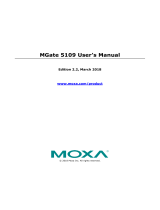
1MAC052634-MB D Section 3
Vendor-specific implementation
615/620 series ANSI 11
Communication Protocol Manual
Table 1: Serial diagnostic counters
3.1.1.3 Character framing in different serial link modes
According to the Modbus standard, the character length in the Modbus RTU mode should
be 11 bits and in Modbus ASCII mode 10 bits. It is possible to freely define the character
parity: even, odd or no parity. No parity means that the bit length of the serial character is
reduced by one. Thus, the character is compensated with an additional stop bit.
Table 2: RTU characters
Table 3: ASCII characters
3.1.2 TCP/IP link
The IED operates as a Modbus TCP/IP server. A Modbus TCP/IP client can establish a
connection to the IED through the standardized TCP socket port 502.
The Modbus TCP/IP interface of the IED can be configured to accept several simultaneous
Modbus client connections. It is possible to grant connections only to the predefined
TCP/IP clients. The write authority of the Modbus TCP/IP client is configurable.
Counter Description
Received frames
N
Total amount of received Modbus frames. For example, the Modbus frames that are
addressed to this instance.
Transmitted
frames N
Total amount of transmitted Modbus responses.
Cksm Err N Total amount of detected Modbus checksum errors.
The Modbus instance only calculates checksums of Modbus frames that contain a
proper link address. All other incoming Modbus frames are discarded.
Transmitted Exc
A N
Total amount of exception responses 1 and 2.
These exception responses usually reveal configuration errors on the Modbus client
side. Either the client uses a request function code which is not supported or the
requested Modbus point(s) does not exist.
Transmitted Exc
B N
Total amount of exception responses 3.
These exceptions usually reveal the IED application level rejections. That is, the IED
application rejects the request at this moment, under the current circumstances. The
exception can also mean that the value in the Modbus write request is out of range.
Status N Shows the value “True” if the serial instance is in use. This indicates that the Modbus
client is connected and Modbus messages, which are addressed to the device, are
received regularly at least with a 30 second interval or faster. In all other cases this
value is “False”. Resetting of all diagnostic counters in the instance N is done by
writing value “True” into this same Status N object.
Coding system 8-bit binary
Bits per
character
1 start bit
8 data bits, the least significant bit is sent first
1 bit for even/odd parity; no bit if parity is not used
1 stop bit if parity is used; 2 stop bits if parity is not used
Coding system Two ASCII characters representing a hexadecimal number
Bits per
character
1 start bit
7 data bits, the least significant bit is sent first
1 bit for even/odd parity; no bit if parity is not used
1 stop bit if parity is used; 2 stop bits if parity is not used




















